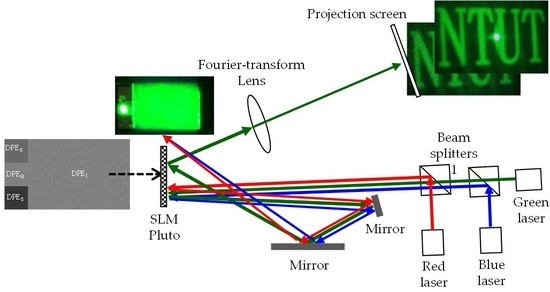Compact Holographic Projection Display Using Liquid-Crystal-on-Silicon Spatial Light Modulator
Abstract
:1. Introduction
2. Holographic Display Using a Single SLM
2.1. System Schematic
2.2. Beam Shaping of Laser Sources
2.3. Display of Holographic Images
2.4. Speckle Reduction
3. Conclusions
- Producing full-color imaging by temporal integration of elementary red/green/blue images.
- Increasing the efficiency of speckle reduction and decrease the number of the integrated speckled images by integrating the negatively correlated speckle images [18].
- Producing virtual images from the diffractive phase elements.
- Using fibers to introduce laser light.
Acknowledgments
Author Contributions
Conflicts of Interest
References
- Tsang, P.W.M.; Poon, T.-C. Review on the state-of-the-art technologies for acquisition and display of digital holograms. IEEE Trans. Ind. Inform. 2016, 12, 886–901. [Google Scholar] [CrossRef]
- Cable, A.J.; Buckley, E.; Mash, P.; Lawrence, N.A.; Wikinson, T.D.; Crossland, W.A. Real-time binary hologram generation for high-quality video projection applications. Proc. SID Int. Symp. Dig. Tech. Pap. 2004, 35, 1431–1433. [Google Scholar] [CrossRef]
- Jesacher, A.; Maurer, C.; Schwaighhofer, A.; Bernet, S.; Ritsch-Marte, M. Near-perfect hologram reconstruction with a spatial light modulator. Opt. Express 2008, 16, 2597–2603. [Google Scholar] [CrossRef] [PubMed]
- Palima, D.; Glückstad, J. Comparison of generalized phase contrast and computer generated holography for laser image projection. Opt. Express 2008, 16, 5338–5349. [Google Scholar] [CrossRef] [PubMed]
- Buckley, E. Holographic laser projection. J. Disp. Technol. 2011, 7, 135–140. [Google Scholar] [CrossRef]
- Zheng, H.D.; Yu, Y.J.; Wang, T.; Asundi, A. Computer generated kinoforms of real-existing full-color 3D objects using pure-phase look-up-table method. Opt. Lasers Eng. 2012, 50, 568–573. [Google Scholar] [CrossRef]
- Chang, Y.-S.; Hsu, W.-F.; Hsu, K.-H.; Lin, H.Y. Full-frame projection displays using a liquid-crystal-on-silicon spatial light modulator for beam shaping and speckle suppression. Appl. Opt. 2014, 53, G214–G221. [Google Scholar] [CrossRef] [PubMed]
- Zhao, Y.; Cao, L.; Zhang, H.; Tan, W.; Wu, S.; Wang, Z.; Yang, Q.; Jin, G. Time-division multiplexing holographic display using angular-spectrum layer-oriented method. Chin. Opt. Lett. 2016, 14, 010005. [Google Scholar] [CrossRef]
- Kim, Y.S.; Kim, T.; Woo, S.S.; Kang, H.; Poon, T.-C.; Zhou, C. Speckle-free digital holographic recording of a diffusely reflecting object. Opt. Express 2013, 21, 8183–8189. [Google Scholar] [CrossRef] [PubMed]
- Liu, J.-P.; Guo, C.-H.; Hsiao, W.-J.; Poon, T.-C.; Tsang, P. Coherent experiments in single-pixel digital holography. Opt. Lett. 2015, 40, 2366–2369. [Google Scholar] [CrossRef] [PubMed]
- Sun, J.; Wu, S.-T. Recent advances in polymer network liquid crystal spatial light modulators. J. Polym. Sci. B Polym. Phys. 2014, 52, 183–192. [Google Scholar] [CrossRef]
- Kubota, S.; Goodman, J.W. Very efficient speckle contrast reduction realized by moving diffuser device. Appl. Opt. 2010, 49, 4385–4391. [Google Scholar] [CrossRef] [PubMed]
- Trisnadi, J.I. Hadamard speckle contrast reduction. Opt. Lett. 2004, 29, 11–13. [Google Scholar] [CrossRef] [PubMed]
- Shin, S.C.; Yoo, S.S.; Lee, S.Y.; Park, C.-Y.; Park, S.Y.; Kwon, J.W.; Lee, S.-G. Removal of hot spot speckle on rear projection screen using the rotating screen system. J. Disp. Technol. 2006, 2, 79–84. [Google Scholar] [CrossRef]
- Sun, M.; Lu, Z. Speckle suppression with a rotating light pipe. Opt. Eng. 2010, 49, 024202. [Google Scholar] [CrossRef]
- Wang, L.; Tschudi, T.; Halldórsson, T.; Pétursson, P.R. Speckle reduction in laser projection systems by diffractive optical elements. Appl. Opt. 1998, 37, 1770–1775. [Google Scholar] [CrossRef] [PubMed]
- Hsu, W.-F.; Yeh, C.F. Speckle suppression in holographic projection displays using temporal integration of speckle images from diffractive optical elements. Appl. Opt. 2011, 50, H50–H55. [Google Scholar] [CrossRef] [PubMed]
- Wyrowski, F.; Bryngdahl, O. Iterative Fourier-transform algorithm applied to computer holography. J. Opt. Soc. Am. A 1988, 5, 1058–1065. [Google Scholar] [CrossRef]
- Poon, T.-C.; Liu, J.-P. Introduction to Modern Digital Holography: With Matlab; Cambridge University Press: Cambridge, UK, 2014; p. 187. [Google Scholar]
- Goodman, J.W. Introduction to Fourier Optics, 3rd ed.; Roberts & Company: Englewood, CO, USA, 2005; p. 75. [Google Scholar]
- Hsu, W.-F. Backward iterative quantization methods for designs of multilevel diffractive optical elements. Opt. Express 2005, 13, 5052–5063. [Google Scholar] [CrossRef] [PubMed]
- Wyrowski, F.; Bryngdahl, O. Speckle-free reconstruction in digital holography. J. Opt. Soc. Am. A 1989, 6, 1171–1174. [Google Scholar] [CrossRef]
- Goodman, J.W. Speckle Phenomena in Optics: Theory and Applications; Roberts & Company: Englewood, CO, USA, 2007; p. 28. [Google Scholar]
- Hsu, W.-F.; Chu, I.-L. Speckle suppression by integrated sum of fully developed negatively correlated patterns in coherent imaging. Prog. Electromagn. Res. B 2011, 34, 1–13. [Google Scholar] [CrossRef]
- Kuratomi, Y.; Sekiya, K.; Satoh, H.; Tomiyama, T.; Kawakami, T.; Katagiri, B.; Suzuki, Y.; Uchida, T. Speckle reduction mechanism in laser rear projection displays using a small moving diffuser. J. Opt. Soc. Am. A 2010, 27, 1812–1817. [Google Scholar] [CrossRef] [PubMed]










© 2016 by the authors; licensee MDPI, Basel, Switzerland. This article is an open access article distributed under the terms and conditions of the Creative Commons Attribution (CC-BY) license (http://creativecommons.org/licenses/by/4.0/).
Share and Cite
Hsu, W.-F.; Weng, M.-H. Compact Holographic Projection Display Using Liquid-Crystal-on-Silicon Spatial Light Modulator. Materials 2016, 9, 768. https://doi.org/10.3390/ma9090768
Hsu W-F, Weng M-H. Compact Holographic Projection Display Using Liquid-Crystal-on-Silicon Spatial Light Modulator. Materials. 2016; 9(9):768. https://doi.org/10.3390/ma9090768
Chicago/Turabian StyleHsu, Wei-Feng, and Ming-Hong Weng. 2016. "Compact Holographic Projection Display Using Liquid-Crystal-on-Silicon Spatial Light Modulator" Materials 9, no. 9: 768. https://doi.org/10.3390/ma9090768






